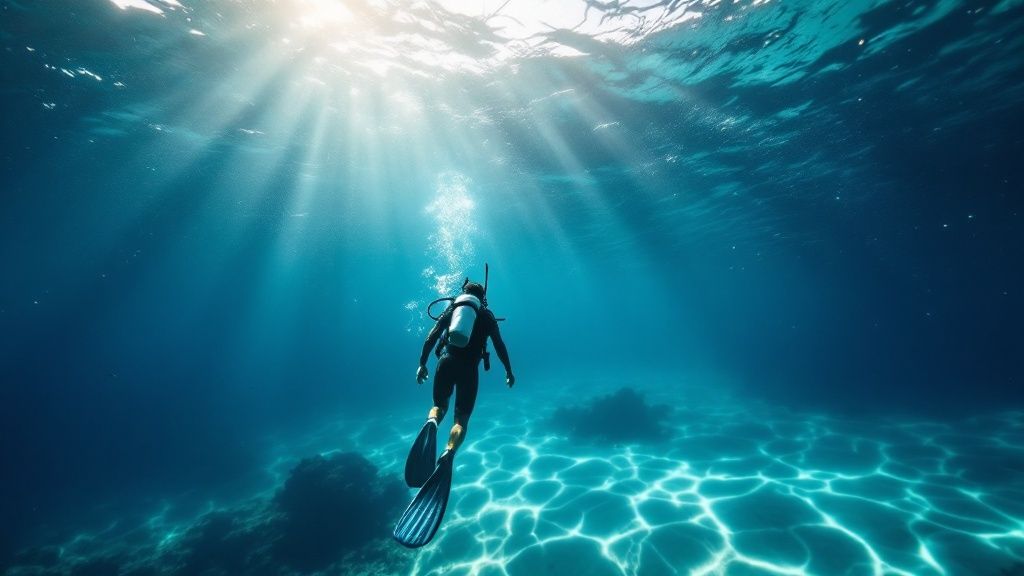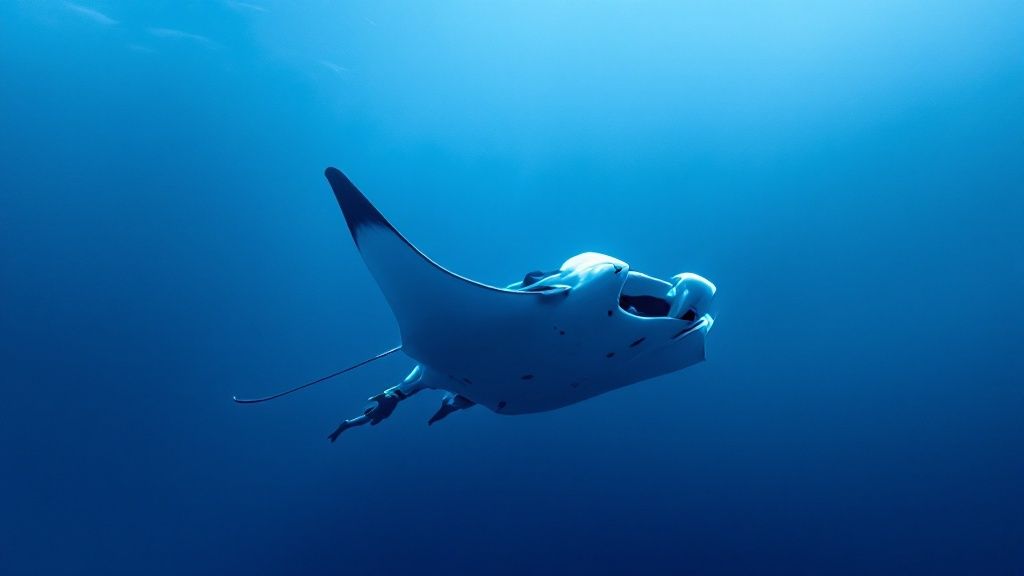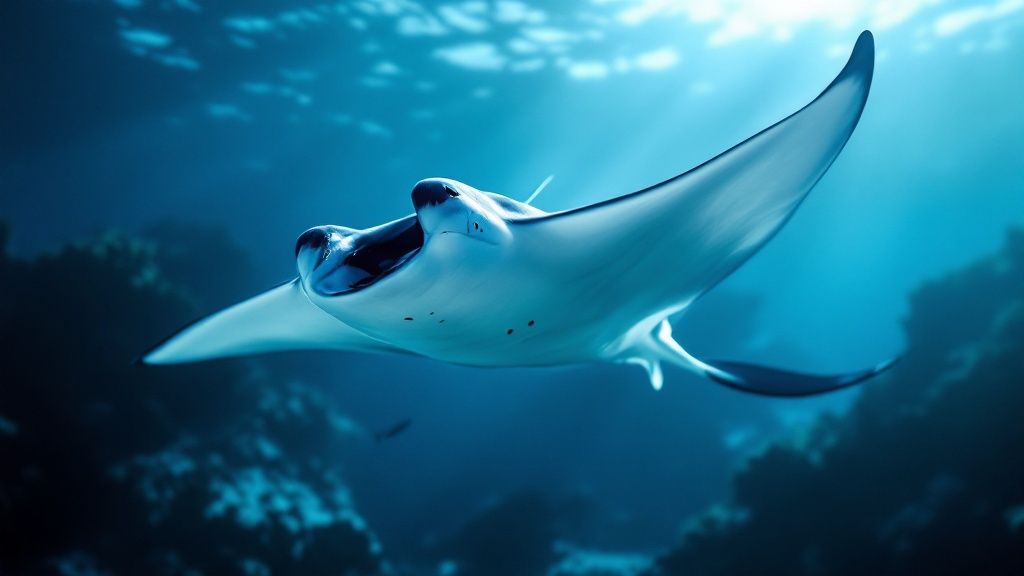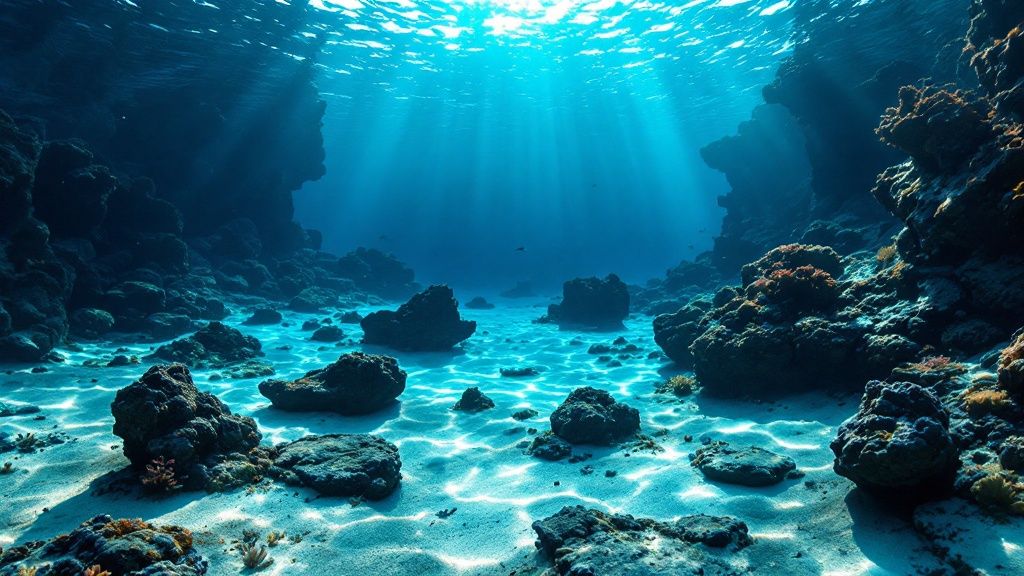Big Island Manta Ray Snorkel: Explore Hawaiian Waters!
- Byron
- Mar 17
- 11 min read
Why Big Island Manta Ray Snorkel Transforms Ocean Experiences
A Big Island manta ray snorkel is more than just another ocean activity. It's a truly special experience, blending natural wonder with scientific discovery and sustainable tourism. This makes it a must-do activity for any visitor to Hawaii. The unique combination of these elements has transformed manta ray snorkeling from a niche interest into a highly sought-after, bucket-list adventure.
The Magic of Nighttime Viewing
The magic of the Big Island manta ray snorkel lies in the unique nighttime viewing approach. After sunset, tour operators strategically place specialized lights in the water. These lights attract plankton, the manta ray's main food source. As the mantas gracefully feed on the microscopic organisms, they create a breathtaking underwater ballet. The darkness amplifies the visual impact, making it an unforgettable sight.
Conservation and Responsible Tourism
The Big Island manta ray snorkel provides a profound connection to marine conservation, particularly for eco-conscious travelers. The experience fosters a deep appreciation for these gentle giants and their delicate ecosystem. Responsible tour operators prioritize sustainable practices and educate participants about the importance of protecting manta rays and their habitat. This emphasis on environmental responsibility adds to the overall positive impact of the experience.
Manta ray night snorkeling's popularity on the Big Island has exploded in recent years. It's not just thrilling, but also educational, teaching participants about the Hawaiian ecosystem and responsible tourism. Since 2020 legislation restricted dolphin encounters, manta ray snorkeling has become a popular alternative for interacting with marine life responsibly and safely. Manta rays are gentle creatures, rarely showing aggression, making them ideal for close encounters. Snorkelers swim near illuminated flotation devices that attract phytoplankton, which in turn attract the manta rays. This allows for incredible views of these magnificent creatures performing barrel rolls just below. Learn more here.
A Lasting Impact
The Big Island manta ray snorkel offers more than just a fleeting moment of awe. It creates a lasting impression, often inspiring a deeper connection to the ocean and a greater understanding of marine conservation’s importance. This experience often instills a desire to protect these creatures and their environment, contributing to long-term positive change. The Big Island manta ray snorkel exemplifies how tourism and environmental stewardship can combine to create an enriching and sustainable experience.

Prime Locations For Your Big Island Manta Ray Snorkel
Embarking on a Big Island manta ray snorkel is an unforgettable experience. Choosing the right location is crucial for a truly remarkable encounter. The Kona Coast, known for its reliable manta ray sightings, offers diverse locations to suit various preferences.
Manta Village and Manta Heaven: Kona Coast Gems
Two popular spots, Manta Village and Manta Heaven, boast consistently high chances of witnessing these gentle giants. Their reputations stem from unique oceanographic features. Nutrient-rich currents attract plankton, the manta ray's main food source. This creates predictable feeding opportunities, allowing snorkelers to observe these magnificent creatures in action. You can find additional information on our sitemap.
The Kona Coast's frequent manta ray sightings have made it a research hotspot. From 2009 to 2014, detailed records from sites like Manta Village and Manta Heaven helped researchers understand manta ray travel patterns and predict sightings. Tracking individual mantas, noting their condition, and compiling monthly statistics contributed significantly to our understanding of their behavior and habitat preferences. More detailed statistics are available here.
Exploring Other Prime Snorkel Spots
Beyond these well-known spots, other prime locations around the Big Island offer unique experiences. Each spot possesses distinctive features, like seasonal currents and plankton concentrations, that influence sighting success.
Keauhou Bay: Known for its calm waters and easy access, Keauhou Bay is an excellent choice for families and less-experienced snorkelers.
Makako Bay: This bay offers a more intimate, small-group setting for a personalized manta ray experience.
Kohala Coast: Further north, the Kohala Coast occasionally hosts visiting mantas, providing a different perspective on these majestic creatures.
To help you choose the best spot for your adventure, we've compiled a comparison of the top locations:
Top Manta Ray Snorkel Locations on Big Island: Comparison of the best locations for manta ray snorkeling experiences, including success rates, accessibility, and special features.
Location | Success Rate | Best Time | Group Size | Special Features |
|---|---|---|---|---|
Manta Village | High | Year-round | Large | Consistent sightings, easy access |
Manta Heaven | High | Year-round | Large | Predictable feeding opportunities |
Keauhou Bay | Moderate | Year-round | Varies | Calm waters, family-friendly |
Makako Bay | Moderate | Summer/Fall | Small | Intimate encounters |
Kohala Coast | Occasional | Varies | Varies | Unique perspective |
As you can see, each location offers a unique experience, so you can choose the best one based on your priorities and preferences.
Choosing Your Ideal Departure Point
Selecting the right departure point simplifies your Big Island manta ray snorkel adventure. Kona, the primary hub for manta ray tours, offers convenient access to most viewing sites. Some operators depart from other coastal locations, catering to those staying in different areas of the island. Considering travel time and ocean conditions ensures a smooth and enjoyable journey. Careful planning and location selection will make your Big Island manta ray snorkel a truly unforgettable experience.

The Magnificent Mantas: Stars of Your Nighttime Adventure
Prepare to be mesmerized by the true stars of the Big Island manta ray snorkel: the magnificent manta rays. These gentle giants, with their graceful movements and captivating behaviors, transform a simple nighttime snorkel into an unforgettable adventure. Understanding their unique adaptations and characteristics elevates the experience, forging a deeper connection with these remarkable creatures.

Understanding Manta Ray Biology
Manta rays are perfectly adapted to their ocean home. Their expansive, wing-like pectoral fins propel them effortlessly through the water. Their cephalic fins, positioned near their mouths, act like funnels, guiding plankton-rich water directly to their mouths. This efficient feeding strategy allows them to consume large amounts of microscopic organisms, supporting their impressive size.
Hawaii's manta ray population includes two distinct species: the reef manta ray (Mobula alfredi) and the oceanic manta ray (Mobula birostris). Reef mantas typically boast a wingspan of up to 14 feet, while oceanic mantas can reach an astounding 26 feet. During snorkeling tours, however, the mantas typically encountered range between 5-10 feet in wingspan. Each manta ray possesses a unique spot pattern on its underside, much like a human fingerprint, aiding in individual identification. This unique characteristic allows tour guides and researchers to recognize and even name individual mantas, adding a personal touch to the snorkeling encounter. Discover more insights about manta rays.
Intelligence and Social Behavior
Beyond their physical adaptations, manta rays exhibit remarkable intelligence. They possess the largest brain-to-body ratio of any fish, indicating complex cognitive abilities. Mantas have been observed displaying curious behaviors, interacting with divers and snorkelers, and even engaging in playful activities.
Furthermore, mantas demonstrate intricate social interactions, often congregating in groups to feed or socialize. These gatherings, referred to as "feeding aggregations" or "manta trains," create a breathtaking spectacle.
The Manta Ray's Ecological Role
Manta rays play a crucial role in maintaining a healthy marine ecosystem. As filter feeders, they help regulate plankton populations, contributing to the overall balance of the ocean. Their feeding activity also generates a localized upwelling effect, bringing nutrient-rich waters to the surface and benefiting other marine life.
The presence of manta rays signifies a thriving ecosystem. This understanding underscores the importance of conservation efforts to protect these gentle giants and their oceanic habitat. By participating in a Big Island manta ray snorkel, you're not just witnessing a natural wonder; you're also supporting sustainable tourism that directly benefits these incredible animals.
Crafting Your Perfect Big Island Manta Ray Experience
Turning your Big Island manta ray snorkel dream into a reality takes more than just picking a date. It requires careful planning and understanding the factors that contribute to a truly unforgettable experience. From selecting the right tour operator to knowing the best time to go, this guide provides the information you need to make the most of this incredible opportunity.
Choosing a Tour Operator: Beyond the Price Tag
Price is definitely a consideration, but it shouldn’t be the only factor when choosing a Big Island manta ray snorkel tour. Several key aspects set operators apart. Guide expertise, for example, is essential. Knowledgeable guides understand manta ray behavior, the best viewing spots, and, most importantly, safety protocols. They enrich your experience with insightful commentary and ensure a safe and respectful interaction with the mantas.
Group size also greatly influences the experience. Smaller groups offer a more personalized experience with the guide and a less crowded viewing environment. Vessel comfort is another important factor, particularly for longer tours. Look for operators with stable, spacious boats featuring amenities like restrooms and comfortable seating. And always prioritize operators who emphasize safety protocols, including thorough safety briefings, proper equipment, and certified lifeguards.
Timing Your Adventure for Maximum Manta Magic
Timing your adventure strategically significantly improves your chances of a successful Big Island manta ray snorkel. The moon phase plays a vital role. Plankton, the mantas' primary food source, are attracted to light. A new moon creates darker conditions, concentrating plankton near the tour boats' lights, which, in turn, attracts more mantas.
Seasonal patterns also influence manta ray activity. Mantas are present year-round, but the summer months (June-August) generally offer calmer waters and better visibility. This is also peak season, so booking in advance is crucial. The success rate for spotting manta rays on night snorkeling trips on the Big Island is high. Mantas are seen on average 85-90% of the time, though sightings are never guaranteed since they are wild animals. To help manage expectations, operators like Jack's Diving Locker provide a "Manta Report" with recent sighting data and weather forecasts. Find more detailed statistics here.
Catering to Diverse Needs
Big Island manta ray snorkel tours cater to a variety of needs. Families with children can select operators specializing in family-friendly tours with guides experienced in working with young snorkelers. For anxious swimmers, tours with smaller groups in calm bay locations can help alleviate concerns. Photography tours, equipped with special lighting and professional photographers, cater to those wanting to capture stunning underwater images.
Asking the Right Questions
Before booking, asking potential tour operators the right questions can reveal valuable information. Inquire about the guide's experience, their safety procedures, their group size policy, and their success rates. Don’t hesitate to ask about their environmental practices and how they minimize their impact on the manta ray population and its habitat. This research helps ensure you’re choosing a reputable operator dedicated to providing a safe, enjoyable, and environmentally responsible experience. By carefully considering these factors, you can turn your Big Island manta ray snorkel dream into an unforgettable reality, personalized to your preferences.

Staying Safe During Your Big Island Manta Ray Snorkel
Experiencing a nighttime manta ray snorkel is a truly memorable adventure, but safety should always come first. Responsible tour operators prioritize safety with a multi-layered approach, ensuring everyone has a secure and enjoyable time. Knowing what to look for in a safety-conscious tour is key to making informed decisions and enjoying your adventure with confidence.
Essential Safety Markers of Reputable Tours
A safety-focused tour starts well before you enter the water. Look for operators offering comprehensive pre-trip briefings that cover everything from snorkeling techniques to emergency procedures. Small group sizes are also important, allowing guides to provide personalized attention and supervision. Confirm that guides are certified lifeguards or hold equivalent qualifications and that the tour operators have necessary safety equipment, such as flotation devices and first-aid kits.
It's also crucial to ask about the operator's emergency action plan. A well-prepared operator will have clear protocols for unexpected situations, like a participant struggling in the water or sudden weather changes. Reliable communication systems, both on the boat and in the water, are essential for staying in contact with the shore and other vessels.
Managing Common Concerns: Night Water Anxiety and Seasickness
Entering the ocean at night can be intimidating for some. Reputable operators understand night water anxiety and take steps to ease concerns. Proper illumination, both on the boat and in the water, ensures good visibility and reduces unease. Experienced guides clearly explain procedures, building confidence and providing reassurance. Check out our guide on Big Island manta ray experiences.
Seasickness is another common concern. Choose operators with stable vessels and consider taking motion sickness medication beforehand. Staying hydrated and avoiding large meals before the trip can also help. If you're prone to seasickness, discuss your concerns with the operator in advance.
In-Water Safety Procedures: Maintaining Your Position
Once in the water, maintaining the correct position is vital for both your safety and the manta rays' well-being. Guides usually designate viewing areas, often marked by flotation devices, to keep the group together and minimize disturbance to the mantas. They provide instructions on using flotation aids and how to avoid touching or kicking the manta rays.
Experienced guides establish a secure environment by positioning the group strategically in relation to the manta rays' feeding patterns. They explain how to avoid interfering with the mantas and how to understand their behavior, ensuring respectful and safe interactions. Safety assessments for manta ray viewing operations on the Big Island have raised some concerns. Locations like Makako Bay and Keauhou Bay see high participant numbers, with up to 28 vessels and over 290 people in the water on busy nights, increasing accident risk. While serious accidents are rare, better management and regulation are needed to address the risks associated with this high activity. Learn more here.
Special Considerations for Families and Individuals With Specific Needs
Responsible operators cater to a variety of needs. Families with children benefit from guides experienced with younger snorkelers. Those with limited swimming experience can choose tours in calmer waters with additional support. Operators also offer guidance for individuals with specific health concerns, ensuring everyone can safely and appropriately participate in this incredible activity.
From Shore to Spectacle: Your Night With Manta Rays
Your Big Island manta ray snorkel adventure begins long before you dip your toes in the water. This guide walks you through a typical evening, setting the stage for what you can expect from beginning to end. This preview will help you prepare for an experience often described as truly breathtaking.
Check-In and Briefing: The Prelude to Your Adventure
Your evening typically starts with check-in at the tour operator's meeting spot. This might be a harbor, a beach, or even a resort. You’ll meet your guides and fellow snorkelers, and after quick introductions, you'll receive a thorough safety briefing. This covers essential snorkeling techniques, how to use the equipment, and respectful manta ray interaction guidelines. This briefing is especially important for first-time snorkelers or anyone feeling a little nervous about a nighttime ocean excursion. The guides will answer all your questions to ensure everyone feels comfortable and prepared. You might be interested in our blog category sitemap for more information on snorkeling and other related topics.
Boat Journey: Setting the Stage
Next, you'll embark on a short boat trip to the snorkel site, usually a spot known for consistent manta ray sightings. During the ride, your guides might share fascinating facts about manta ray biology and behavior, building excitement for the encounter. The boat ride itself is a lovely experience, often with stunning sunset views of the Pacific. This is a perfect time to relax and take in the beauty of the Hawaiian coastline.
Entering the Water: A Carefully Orchestrated Entry
When you arrive at the snorkel site, the guides will explain the entry procedure. This usually involves a carefully planned approach to minimize disturbing the mantas and maximize viewing. You'll likely enter the water calmly and gather in a specific area, often illuminated by special lights to attract plankton. These lights create a "manta ray dining room," bringing these gentle giants to the surface for their evening meal.
Floating and Observing: The Manta Ray Ballet
Once in the water, you’ll experience the unique sensation of floating in the dark ocean, lit by the underwater lights. It might take a few moments for your eyes to adjust, then the magic begins. The mantas, drawn by the plankton, appear. They glide gracefully beneath you, their enormous wingspans creating a mesmerizing ballet. You'll see their feeding behaviors up close, marveling at their graceful movements and effortless navigation.
Before we delve further into the experience, let's compare different tour options available:
Big Island Manta Ray Tour Comparison: This table compares different tour types, prices, and what's included for big island manta ray snorkel experiences.
Tour Type | Average Duration | Price Range | Group Size | Inclusions | Best For |
|---|---|---|---|---|---|
Basic Snorkel Tour | 1.5-2 hours | $100-$150 | 10-20 people | Snorkel gear, boat ride, guide | Budget-conscious travelers, first-timers |
Deluxe Snorkel Tour | 2-2.5 hours | $150-$200 | 6-10 people | Snorkel gear, wetsuit, boat ride, guide, snacks, drinks | Enhanced comfort, smaller groups |
Private Snorkel Charter | Flexible | $500-$1000+ | Customizable | Snorkel gear, boat ride, dedicated guide, personalized itinerary | Families, groups, exclusive experience |
As you can see, there are several choices depending on your budget and preferences. A private charter provides a more exclusive experience while basic tours offer a great value.
Communication and Positioning: Enhancing Your Experience
The guides play a key role in your experience. They use underwater communication systems to update the group on approaching mantas and interesting behaviors. They’ll also help you position yourself for respectful viewing and optimal sightings. Following their directions is crucial, for your safety and the well-being of the manta rays. Their expertise creates a memorable and educational experience, allowing you to connect with these majestic creatures. This is a moment you’ll remember long after you leave the water.
Ready to experience the magic? Book your Manta Ray Night Snorkel Kona Hawaii Tour today!
Comments